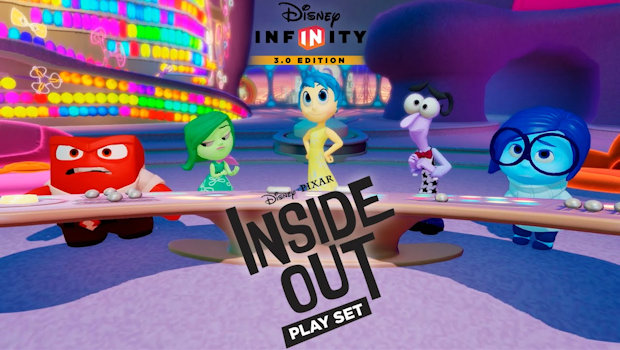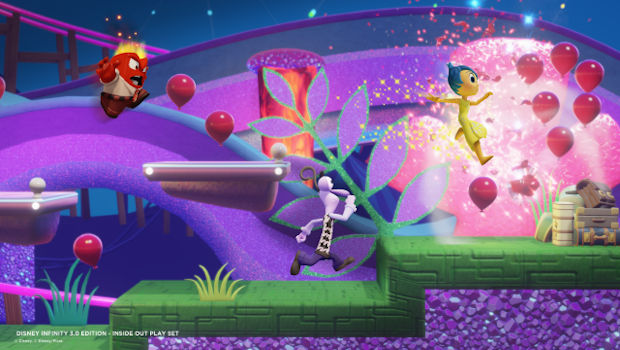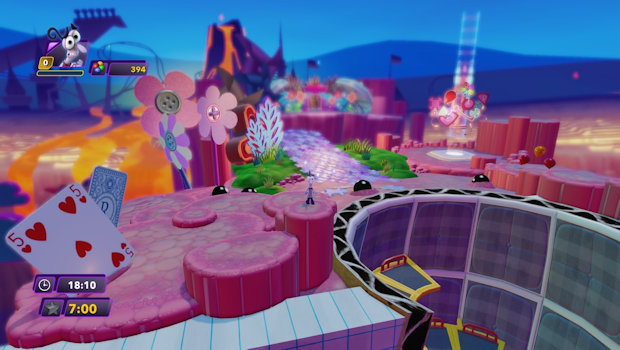Pixar is no stranger to Disney Infinity. In fact, the first game in Disney’s popular toys-to-life series was 2/3 founded on their backs, with Monster’s University, The Incredibles, Cars, and Toy Story being featured in that game (the other 1/3 being Johnny Depp’s back). So, it is no surprise that Disney 3.0 sees Pixar’s newest property Inside Out get its own playset.
For those new to Disney Infinity, playsets are the scripted game sequences that are triggered in the game by placing a crystal playset token on the centerpiece of the Infinity portal. Some of these, like the Twilight of the Republic set, come with the starter pack for the game, while others are purchased separately. These playsets are not needed to experience the bulk of what Disney Infinity has to offer but if one is looking for a professionally designed campaign, this is your ticket. A ticket that generally costs between $30 and $40.
As previously mentioned, Inside Out is Pixar’s newest property. The film, which came out this past June to both critical and commercial success, focuses on the emotions inside the mind of Riley, a pre-teen girl that has had her life uprooted by her parents’ recent move across the country. Disney Infinity 3.0’s Inside Out playset sees players return to the inside of Riley’s head as Joy and Anger, two of the characters from the film. The rest of the emotion team, Fear, Disgust, and my personal favorite Sadness, are all available for purchase separately outside of the playset pack.
The playset campaign is designed as a hybrid platformer. Levels are done in a mix of 2D and 3D. To compare it to everyone’s platforming touchstone, some of the levels are designed like classic sidescrolling Super Mario Bros levels, while others are more reminiscent of the more modern 3D Mario games, like the latest in the series, Super Mario 3D World. This may sound a bit confusing but it works, for the most part.
Regardless of if you are playing a 2D sidescrolling or 3D open-world platformer, the objective remains the same: get Riley’s memories (little glowing orbs) and return them to the receptacles to be re-filed. Along the way there are other side objectives to accomplish, like popping all the balloons, collecting the hidden memory manual pages, or finding an idea light bulb. These additional objectives feed into your overall level score, which is complete with leaderboards, and can also unlock some bonus goodies for fans of the film. It’s all pretty straightforward and the beginning levels, while beautifully colorful don’t necessarily test your platforming skill in any way.
Things however, get interesting as you progress in the game. The levels start to introduce some additional elements to the game that tie directly to the characters you can play as. For example Joy can do a double jump, Anger can walk on lava, Sadness can float on clouds, etc… These elements are then tied to areas of the game that make the levels more complicated with challenges that correspond to character specific traits. And these sections, where you are forced to use a character specific power, are the most fun sections of the game. And unlike Skylanders, which walls off some of its content based on specific characters, the Inside Out playset does something very smart and allows for players to temporarily morph into another character and get their powers. And you’ll need to use these powers if you plan on finishing the campaign.
Another smart thing the playset does is that, if you happen to die by falling off a cloud, getting burned by lava, or whatever, the playset doesn’t penalize you by forcing you to temporarily sit that character down like it does in other playsets and modes. If you die, it just boots you back to the last checkpoint and allows you to start it over. It’s just a smart piece of game design that allows this playset to work as a separate stand alone game.
While most of the game and its design is smart and fun, there are a few little issues that cropped up and made me scratch my head. The first one deals with level progression. Most of the time beating a level will unlock the next one for players but, occasionally, I was forced back to the memory center to play a poorly designed match three game. Once I gained a certain score, this unlocked a new level and I was back to platforming as usual. It’s just a weird choice to gate progression behind a device that is never really explained or utilized more than once or twice. The second issue was the lack of cohesion the playset has. There really isn’t any coherent reason for the emotions to go on this adventure and while that wouldn’t generally be an issue, the game does offer up some weird cutscenes that just don’t work. They’re not funny and like the match three game, they actively take you away from what is good about the game. Which brings me to my final issue that is even more evident because of the previous two. The load times are overly long. This is an issue with Disney Infinity as a whole but the design choices to force you out of the game at certain points, which it needs to load in and out of, take you away from what otherwise is a solid platformer.
Because of self-publishing and the console market embracing indie games, there is no lack of good platforming titles, but Inside Out holds its own. Its being tied to Disney Infinity 3.0 is a bonus as it just offers more to an already very good game. If you already own Disney Infinity 3.0, the Inside Out playset is an easy recommendation. If you don’t but are interested in the game as a whole, it offers an excellent supplement to the toys-to-life experience.


